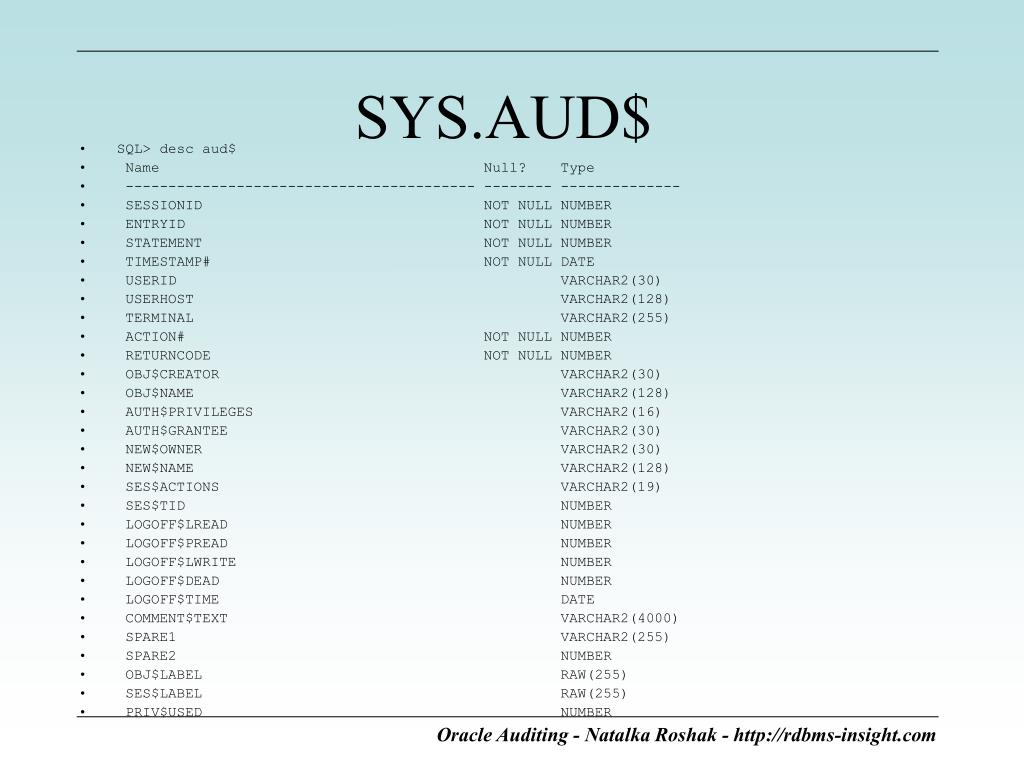Action# In Sys.aud$
Action# In Sys.aud$. That is, sys.aud$ will have a row identifying the select action on itself, as say row1. If select access is required by any.

The majority of cells have the voltage of their external and internal environments. The cell's voltage is measured in millivolts (mV). The typical voltage of an animal cell is around -70 mV. In most cells, minimal voltage fluctuations have been observed for their existence, but in some cells this is an expected feature. Some cells also show variations in the voltage, as they increase and decrease in voltage. The duration of these voltages fluctuate over a large range. In brain cells, the up and down cycle of the action potential is accomplished in less than one thousandth of a second, whereas in other cells, the cycles may take several seconds. The electrical characteristic of an animal cell is influenced by the membrane structure. Cell membrane is made up of one layer of lipids along with proteins. The lipid layer serves as an insulator.
Animal cells are all electrically polarized and maintain an electric voltage which is called membrane potential. For neurons, axonsand dendrites and the cell body possess different electrical characteristics. The most stimulated part of a neuron is the axon hillock. However, the axon, dendrites, and cell body too can be stimulated. At the axon hillock the resting voltage is -70 mV and the threshold potential is 55 mgV. Synaptic signals to the neuron result in depolarization which causes membrane potential to rise or fall. Action potentials are generated when sufficient depolarization takes place and that membrane potential reaches an upper limit.
Action potential is the result on the activities of voltage-gated channels that are found in the plasma membrane of cells. The voltage-gated ion channel actually a cluster composed of proteins that remain in the plasma membrane. This produces action potential because it can produce the positive feedback loop. Membrane potential is the main factor responsible for maintaining the state of the ion channels. Action potential is generated whenever the positive feedback occurs at full strength. The time and the intensity are determined by the bio-physical properties of the ion channels that are voltage-gated. There are a variety of ion channel types that exist that can generate positive feedback circuits that ultimately result in the production of these potentials. The sodium channels that are voltage-gated participate in the generation of higher-frequency potentials that mimic those of nerve impulse. More slow ones such as those produced in muscle cells are controlled by the calcium ion channels.The most studied voltage-gated Ion channels are sodium ion networks that play an important role in faster nerve impulse communication.
There are a few options available to you to manage this, but these will depend on what version of 10g you have installed. Auditing is the monitoring and recording of selected user database actions. The audit records are written to the operating system's audit trail.
To Find Out Meaning Of The Column Check Audit_Actions Table.
This leaves one record in sys.aud$ with an action of 7; First question, what for and second, oracle doesn't have a. For all dbas who need to be careful about the sys.aud$ table growth and manage appropriate cleanup.
Returncode Value In Sys.aud$ Returncode Value In Sys.aud$ Rogersj (Technicaluser) (Op) 11 Oct 05 12:35.
Brief of following parameter values: Did you mean that you want generate a backup from the aud$ table for a specific time? During sox auditing, some logon/logoff for sys records were found in sys.aud$:
That Is, Sys.aud$ Will Have A Row Identifying The Select Action On Itself, As Say Row1.
Auditing is the monitoring and recording of selected user database actions. When the user created a table, the entry in the sys.aud$ is registered as a create table. It is worth to mention that oracle doesn’t recommend creating any indexes on sys.aud$ table as it may degrade the performance of record insertions to sys.aud$, in addition to other minor reasons mentioned in this note:
When The User Issues A Drop Table, The Entry For Drop.
In some cases, the aud$ table should be owned by a user other than sys. The audit records are written to the operating system's audit trail. If you want to filter and analyze your audit data from aud$ table you need to scan data using action# column.
Unexpected Entries Into The Sys.aud$.
I use this script along with the creation of the above index on very busy. As of the 10.2.0.5 patch, a new package, dbms_audit_mgmt was. Only dbas should have maintenance access to the audit trail.
Post a Comment for "Action# In Sys.aud$"